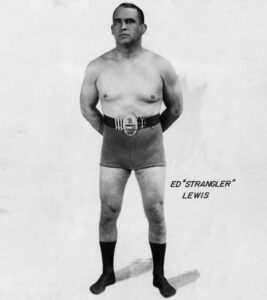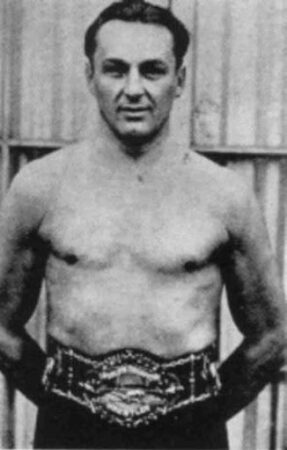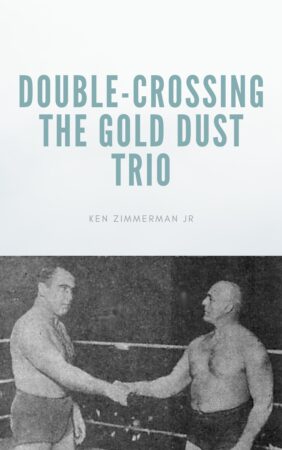לויס און סטעטשער דרייען אַ לעצטע מאָל
די דאַמאַנאַנס פון די גאָלד שטויב טריאָו פון פאַכמאַן ראַנגלעריי אין די פרי צו מיטן 1920 ס ברעד אַ פּלאַץ פון פאַרדראָס מיט אנדערע רעסאַלערז און פּראַמאָוטערז. ד י פראפעסיאנעל ע קנא ה הא ט געפירט א בארימטע ר דאבל־קרײז 1925. פֿון דעסטוועגן אָן, דער וועלט טיטל איז געווען דיספּיוטיד ווי דזשאָו סטעטשער געהאלטן איין ווערסיע, בשעת עד “סטראַנגלער” לויס געהאלטן די אנדערע ווערסיע.
צולי ב דע ר עכטע ר פארדראם , װא ס הא ט עקזיסטיר ט צװיש ן לאנג ע יארן, אַ שידוך צווישן ביידע מענטשן גענומען 3 יאָרן צו באַוואָרענען. According to די האַרבסט גייז: די באַרנומס פון אָפּשפּרונג דורך Marcus Griffin (אַמאַזאָן צוגעבן לינק), די מענטשן האָבן מסכים געווען צו אַ לאַדזשיטאַמאַט קאָנקורס צו פאַרייניקן די וועלט טיטל ווידער.

Photo of “סטראַנגלער” לויס און דזשאָו סטעטשער איידער זיי 1928 גלייַכן אין סט. לוי (ציבור פעלד)
האַרבסט גויס איז אַ טשיקאַווע מישן פון פאַקט און בעלעטריסטיק, אַזוי איך איז געווען סקעפּטיקאַל וועגן דעם פאָדערן דורך גריפין. גריפין ס חשבון וואָלט זיין באזירט אויף צווייטע האַנט אינפֿאָרמאַציע יאָרן נאָך די געשעעניש, אַזוי זיין חשבון קענען ניט זיין גענומען אין פּנים ווערט. אָבער, נאָך לייענען די דיטיילד צייטונג חשבון אין די סט. לוי אַרייַנשיקן-דיספּאַטטש, איך גלויבן, די אינפֿאָרמאַציע פון Griffin איז ריכטיק.
איך געצויגן דעם מסקנא פֿאַר אַ פּאָר פון סיבות. דער ערשטער איז די גלייַכן איז געווען לאַנג און נודנע. די פּראָבלעם מיט פאַכמאַן ראַנגלעריי קאַנטעס איידער די געארבעט טקופע איז באָקע ראַנגלערערז קען סטיילמייט יעדער אנדערער, מאל פֿאַר שעה. רעסאַלערז אנגעהויבן קאָואַפּערייטינג מיט יעדער אנדערע אין געארבעט שוועבעלעך צו מאַכן די גלייַכן מער יקסייטינג און צוציען מער פאָכער אינטערעס. מער יקסייטינג שוועבעלעך געפירט צו ביגער וילעם און מער געלט.

און “סטראַנגלער” לויס מיט זיין וועלט טיטל גאַרטל (ציבור פעלד)
צווייטנס, “סטראַנגלער” Lewis האט נישט נוצן די העאַדלאָקק אין דעם גלייַכן. לויס האט נישט נוצן די העאַדלאָקק אין דרייען קאַנטעס ווייַל עס וואָלט שטעלן אים אין אַ שפּירעוודיק שטעלע מיט זיין קעגנער אויף זיין צוריק.
די מענער האָבן אויסדערוויילט סט. לוי אונטער דער רעספּעקטעד פּראָמאָטער טאָם פּאַקס צו רעסאַל דעם קאָנקורס. הארי שאַרפּע איז געווען דער מסכים אויף שויפעט. דער שידוך איז פארגעקומען מאנטאג, פעברואַר 20, 1928 אין די סט. לוי קאָליסעום.
While “סטראַנגלער” לויס איז געווען פיל סטאַבילער בלויז צוויי פונט אפגעשיידט די מענטשן. לויס האט געוויגט 228. שטעכער האט געװאגט 226.
די מענער האבן אנגעהויבן דעם שידוך, וואָס פּראַגרעסט אין אַ שנעק ס גאַנג פֿאַר די ווייַטער צוויי שעה. לויס בייסיקלי בוליד און פּושט סטעטשער אַרום. סטעטשער ס בלויז העט איז געווען פאַרצווייפלט פרווון צו באַוואָרענען אַ פוס טייקדאַון אויף לויס. גריפין האט געזאגט אַז סטעטשער ינדזשערד לויס’ ריבס מיט אַ פוס שער אָבער סטעטשער פאקטיש ניט אַנדערש אין זיין בלויז צוויי פרווון צו באַוואָרענען זיין ליבלינג האַלטן.
נאָך 2 hours and 16 מינוט, לויס איז ביכולת צו באַוואָרענען אַן אַרמלאַק. טוויסטינג שווער, לויס געצווונגען סטעטשער צו גיין צו די מאַטע אָדער האָבן זיין אַקסל סעפּערייטיד. לויס איז געווען ביכולת צו שטיפט סטעטשער פֿאַר דער ערשטער פאַל.
ד י אויסגעמאטערט ע מענע ר האב ן זי ך פארלאז ט פו ן רינג ן או ן זי ך געפאר ן צ ו זײער ע קלײדער ־ צימער ן פא ר א 20 מינוט ינטערמישאַן. At this point, די מענטשן קען האָבן מסכים צו אַרבעטן די רעשט פון די גלייַכן. לויס האט וואַן די לעצטע לאַדזשיטאַמאַט קאָנקורס צווישן די מענטשן אין די שפּעט 1910 ס. סטעטשער האט מסתמא געוװסט נאך דעם ערשטן פאל, אז דער שידוך װעט גײן אזוי.

דזשאָו סטעטשער מיט זיין טשאַמפּיאַנשיפּ גאַרטל (ציבור פעלד)
נאָך די ינטערמישאַן, סטעטשער האט גלייך פארזיכערט א האנטשלאק און אן דערפאלג פרובירט צו פארזיכערן א פוס שער. אָבער, סטעטשער האָט נישט אַרויסגעלאָזט דעם האַנטגעלענק און די מענער זענען אומגעפאַלן צו דער מאַטע. לויס סטראַגאַלד פֿאַר אַ ביסל מער סעקונדעס אָבער מודה דעם פאַל אין 54 סעקונדעס. עס איז געווען די בלויז פאַקטיש העט פון סטעטשער אין די גלייַכן.
דער דריטער פאַל האָט זיך אָנגעהויבן מיט לויס ווידער דער אַגרעסער. אפילו אויב זיי מסכים צו אַרבעטן נאָך דער ערשטער פאַל, לויס וואָלט נישט לאָזן זיך צו זיין שטעלן אין קיין קאַמפּראַמייזינג שטעלעס אין דעם פאַל.
נאָך סלאַמינג סטעטשער צו די מאַטע צוויי מאָל מיט גוף האלט, לויס סיקיורד אַ טאָפּל-ריסטלאַק. לויס געצווונגען סטעטשער צו די מאַטע, בשעת סטעטשער ס לעגס זענען קלאר אין די ראָפּעס. אָבער, שויפעט הארי שאַרפּע האט נישט ברעכן די מענטשן ווי געוויינטלעך אין רובֿ שוועבעלעך.
לויס יווענטשאַוואַלי פּושט סטעטשער ס פּלייצעס צו די מאַטע פֿאַר די דריט און באַשלאָסן פאַלן. סטעטשער וואָלט פּראָטעסטירן זיין לעגס זענען געווען אין די שטריק צו קיין העלפן.
שויפעט שאַרפּע דערקלערט צו די סט. לוי אַרייַנשיקן-דיספּאַטטש אַז ער דערקלערט צו טאני סטעטשער און בילי סאַנדאָוו, סטעטשער און לויס’ מאַנאַדזשערז ריספּעקטיוולי, אַז ער וואָלט נישט ברעכן פֿאַר די ראָפּעס סייַדן עס איז קלאר ינטערפירינג מיט די ראַנגלער ס פיייקייַט צו באַשיצן זיך. דזשאָו סטעטשער האט נישט פּרווון צו בריק אָדער פאַרטיידיקן אין קיין וועג אנדערע ווי טריינג פֿאַר אַ שטריק ברעכן. דער באַשלוס פון דער שויפעט איז געשטאנען.
שאַרפּע ס אינסטרוקציעס וועגן די ראָפּעס מאַכן זינען ווייַל די באַוט באשטימט סטאַרטעד ווי אַ קאָנקורס אָדער אַ דרייען. אויב די לעצטע צוויי פאלן זענען געארבעט ווי איך כאָשעד, די שטריק סיכסעך וואָלט אויך זיין אַ קלאַסיש ענדיקן צו העלפן סטעטשער קוקן בעסער פֿאַר די פאַנס ווייַל די באַוט ענדיקן איז געווען קאָנטראָווערסיאַל.
אין די האַרבסט גייז, ביידע דזשים לאָנדאָס און רענאַטאָ גאַרדיני, באָקע פאַכמאַן רעסאַלערז בעסער אין ארבעטן ווי שיסערייַ, געווען דאָרט צו היטן די קאָנקורס אַז נאַכט. ביידע מענטשן געדאַנק די סוף פון די גלייַכן איז געארבעט.
לויס’ טריינינג שוטעף יוסף “Toots” מאנדט האָט ווייטער געטענהט אז דער גאנצער גלייַכן איז געווען אַ לעגיטימע קאָנקורס. מאנדט איז געווען ציטירט ווי דערציילט לאָנדאָס און גאַרדיני אַז זיי וועלן נישט וויסן אַ קאָנקורס אויב זיי זען איינער.
די מערסט כידעשדיק זאַך וועגן דעם גלייַכן איז אַז עס איז בלויז געצויגן 7,000 פאַנס צו די קאָליסעום, וואָס אָפט געצויגן צווישן 10,000 און 12,000 fans. דער טויער איז געווען א באריכטעט $65,000 פון וועלכע סטעכער האט באקומען $29,000 און לויס באקומען $19,000. אויב סטעטשער איז געגאנגען צו פאַרלירן זיין פאָדערן צו די טשאַמפּיאַנשיפּ, מ׳האט אים דערפאר גוט באצאלט.
וואָס ווייניק מענטשן געוואוסט אין דער צייט איז די “סטראַנגלער” לויס איז שוין געווען טייל בלינד פון די ווירקונג פון טראַטשאָמאַ, אַ קרענק, וואָס ער האָט אויפֿגענומען פֿון שמוציקע ראַנגלערײַען. אין דער צייט פון דעם גלייַכן, ער האט נאר געקאנט זען די קונצן פון מענטשן. לויס איז געווען אַזוי באָקע אַז ער קען נאָך שלאָגן ווער עס יז וואס דערד צו פּרובירן צו דרייען אויף אים אין די רינג.
נאָך 3 יאָרן, דער וועלט טיטל האט שוין יונאַפייד ווידער. אָבער, טאָפּל-קראָסיז וואָלט פאָרזעצן צו זיין אַן אַרויסגעבן אין פאַכמאַן ראַנגלעריי פֿאַר לויס און זיין סאַקסעסערז. איר שטענדיק האָבן צו זיין אָפּגעהיט מיט די ריזיק עגאָ אין פאַכמאַן ראַנגלעריי.
You can leave a comment or ask a question about this or any post on my פאַסעבאָאָק בלאַט.
Sources: די האַרבסט גייז: די באַרנומס פון אָפּשפּרונג דורך Marcus Griffin און סט. לוי אַרייַנשיקן-דיספּאַטטש, פעברואַר 21, 1928 edition, פּ. 24-25
Pin It

